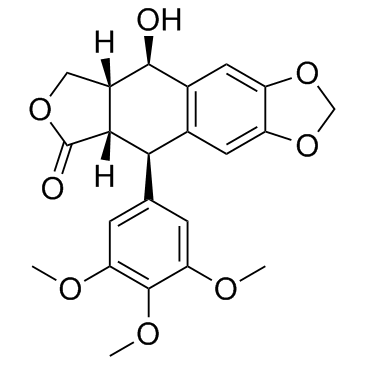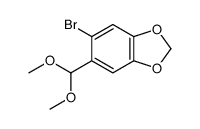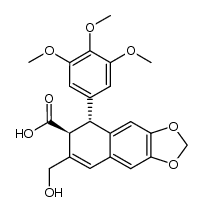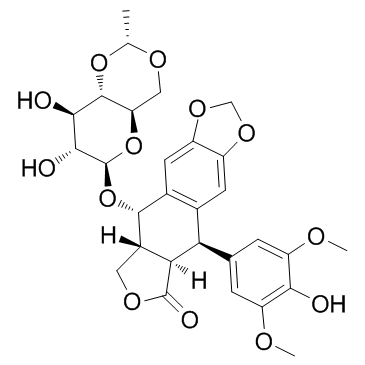Picropodophyllotoxin

Picropodophyllotoxin structure
|
Common Name | Picropodophyllotoxin | ||
|---|---|---|---|---|
| CAS Number | 477-47-4 | Molecular Weight | 414.405 | |
| Density | 1.4±0.1 g/cm3 | Boiling Point | 597.9±50.0 °C at 760 mmHg | |
| Molecular Formula | C22H22O8 | Melting Point | 225-227ºC | |
| MSDS | Chinese USA | Flash Point | 210.2±23.6 °C | |
| Symbol |

GHS06 |
Signal Word | Danger | |
Use of PicropodophyllotoxinPicropodophyllin (AXL1717) is a selective insulin-like growth factor-1 receptor (IGF-1R) inhibitor with an IC50 of 1 nM. |
| Name | picropodophyllotoxin |
|---|---|
| Synonym | More Synonyms |
| Description | Picropodophyllin (AXL1717) is a selective insulin-like growth factor-1 receptor (IGF-1R) inhibitor with an IC50 of 1 nM. |
|---|---|
| Related Catalog | |
| Target |
IC50: 1 nM (IGF-1R) |
| In Vitro | Picropodophyllin (AXL1717) (0.5, 2.5, 10 μM) potently inhibits IGF-1-stimulated IGF-1R, Akt (Ser 473) and Erk1/2 phosphorylation in intact cells. Picropodophyllin (AXL1717) also inhibits cell growth, and induces apoptosis in cultured IGF-1R-positive tumor cells[1]. Picropodophyllin (AXL1717) synergistically sensitizes HMCL, primary human MM and murine 5T33MM cells to ABT-737 and ABT-199 via further decreasing cell viability and enhancing apoptosis[3]. Picropodophyllin and sorafenib synergistically suppress the proliferation and motility of hepatocellular carcinoma cells[4]. |
| In Vivo | Picropodophyllin (AXL1717) (20 mg/kg/12 h, i.p.) causes complete tumor regression in SCID mice xenografted with human ES-1, BE, and PC3[1]. Picropodophyllin (AXL1717) shows a potent antitumor activity, increases survival in the 5T33MM mouse model[2]. |
| Animal Admin | Four to 5-week-old pathogen-free SCID mice are used and housed within plastic isolators in a sterile facility. ES-1, BE, and PC3 cells (all proved to express IGF-1R), or R-v-src (IGF-1R negative) and P12 (overexpressing IGF-1 and IGF-1R), are injected s.c. at 107 cells/mice in a 0.2 mL volume of sterile saline solution. Immunocompetent Balb-c mice are injected with 107JC murine breast cancer cells per mouse in 0.15 mL volume of sterile saline solution. Experimental treatments with Picropodophyllin (AXL1717) (20 mg/kg/12 h) are performed by daily i.p. injections of the compound in 10 μL volume of DMSO: vegetable oil, 10:1 (v/v). Control mice are treated with the vehicle only. Three animals are treated in each group. Tumor growth is measured every second day using vernier calipers, and the tumor volumes are calculated. The mice are carefully observed for the presence of side effects and are sacrificed at the end of the experiments for histological analysis of the lesions. A separate experiment on Picropodophyllin (AXL1717)-treated (systemically and locally) tumor-free mice, including histological analyses of various organs, confirms previous observations that Picropodophyllin (AXL1717) appears to be nontoxic. |
| References |
| Density | 1.4±0.1 g/cm3 |
|---|---|
| Boiling Point | 597.9±50.0 °C at 760 mmHg |
| Melting Point | 225-227ºC |
| Molecular Formula | C22H22O8 |
| Molecular Weight | 414.405 |
| Flash Point | 210.2±23.6 °C |
| Exact Mass | 414.131470 |
| PSA | 92.68000 |
| LogP | 1.60 |
| Vapour Pressure | 0.0±1.8 mmHg at 25°C |
| Index of Refraction | 1.606 |
| Storage condition | 2-8°C |
CHEMICAL IDENTIFICATION
HEALTH HAZARD DATAACUTE TOXICITY DATA
|
| Symbol |

GHS06 |
|---|---|
| Signal Word | Danger |
| Hazard Statements | H301-H312-H315-H319-H335 |
| Precautionary Statements | P261-P280-P301 + P310-P305 + P351 + P338 |
| Personal Protective Equipment | Eyeshields;Faceshields;Gloves;type P2 (EN 143) respirator cartridges |
| Hazard Codes | Xi,T |
| Risk Phrases | 36/37/38-68-25-21 |
| Safety Phrases | 26-36-45-36/37 |
| RIDADR | UN 3462 6.1/PG 2 |
| WGK Germany | 3.0 |
| RTECS | LV2510000 |
| Hazard Class | 6.1 |
| Precursor 5 | |
|---|---|
| DownStream 5 | |
|
Identification of lipid- and protein-based binders in paintings by direct on-plate wet chemistry and matrix-assisted laser desorption ionization mass spectrometry.
Anal. Bioanal. Chem 407(3) , 1015-22, (2015) Direct on-target plate processing of small (ca. 100 μg) fragments of paint samples for MALDI-MS identification of lipid- and protein-based binders is described. Fragments were fixed on a conventional ... |
|
|
The CentriMag centrifugal blood pump as a benchmark for in vitro testing of hemocompatibility in implantable ventricular assist devices.
Artif. Organs 39(2) , 93-101, (2015) Implantable ventricular assist devices (VADs) have proven efficient in advanced heart failure patients as a bridge-to-transplant or destination therapy. However, VAD usage often leads to infection, bl... |
|
|
TIGAR regulates glycolysis in ischemic kidney proximal tubules.
Am. J. Physiol. Renal Physiol. 308(4) , F298-308, (2015) Tp53-induced glycolysis and apoptosis regulator (TIGAR) activation blocks glycolytic ATP synthesis by inhibiting phosphofructokinase-1 activity. Our data indicate that TIGAR is selectively induced and... |
| (5R,5aS,8aR)-9-hydroxy-5-(3,4,5-trimethoxyphenyl)-5,8,8a,9-tetrahydrofuro[3',4':6,7]naphtho[2,3-d][1,3]dioxol-6(5aH)-one |
| Picropodophyllinic Acid Lactone |
| (5R,5aS,8aR,9R)-9-Hydroxy-5-(3,4,5-trimethoxyphenyl)-5,8,8a,9-tetrahydrofuro[3',4':6,7]naphtho[2,3-d][1,3]dioxol-6(5aH)-one |
| Picropodophyllin (8CI) |
| Furo[3',4':6,7]naphtho[2,3-d]-1,3-dioxol-6(5aH)-one, 5,8,8a,9-tetrahydro-9-hydroxy-5-(3,4,5-trimethoxyphenyl)-, (5R,5aS,8aR,9R)- |
| furo[3',4':6,7]naphtho[2,3-d]-1,3-dioxol-6(5aH)-one, 5,8,8a,9-tetrahydro-9-hydroxy-5-(3,4,5-trimethoxyphenyl)-, (5R,5aS,8aR)- |
| [5R-(5a,5aa,8aa,9a)]-5,8,8a,9-Tetrahydro-9-hydroxy-5-(3,4,5-trimethoxyphenyl)furo[3',4':6,7]naphtho[2,3-d]-1,3-dioxol-6(5aH)-one |
| Furo[3',4':6,7]naphtho[2,3-d]-1,3-dioxol-6(5aH)-one,5,8,8a,9-tetrahydro-9-hydroxy-5-(3,4,5-trimethoxyphenyl)-, (5R,5aS,8aR,9R)- |
| Picropodophyllotoxin |
| (5R,5aS,8aR,9R)-5,8,8a,9-Tetrahydro-9-hydroxy-5-(3,4,5-trimethoxyphenyl)furo[3',4':6,7]naphtho[2,3-d]-1,3-dioxol-6(5aH)-one |
| Picropodophyllin |
| PPP |
| IGF-1R Inhibitor |
| AXL1717 |
 CAS#:518-28-5
CAS#:518-28-5 CAS#:74879-22-4
CAS#:74879-22-4 CAS#:87850-43-9
CAS#:87850-43-9 CAS#:477-52-1
CAS#:477-52-1 CAS#:32384-13-7
CAS#:32384-13-7 CAS#:33419-42-0
CAS#:33419-42-0![6-(3,4,5-trimethoxybenzoyl)benzo[1,3]dioxole-5-carboxylic acid structure](https://image.chemsrc.com/caspic/457/7470-99-7.png) CAS#:7470-99-7
CAS#:7470-99-7![7-(3,4,5-trimethoxyphenyl)-[1,3]dioxolo[4,5-f]isobenzofuran-5(7H)-one structure](https://image.chemsrc.com/caspic/349/42123-13-7.png) CAS#:42123-13-7
CAS#:42123-13-7 CAS#:6327-54-4
CAS#:6327-54-4
